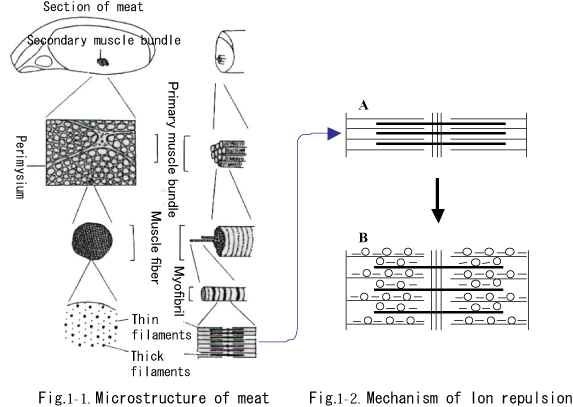Ion Repulsion Technology
This technology was invented
based on medical studies for infants with "congenital
diabetes." (*)
(*) Babies born with diabetes.
Babies with congenital diabetes must take insulin either through injection or intravenously at the same time that they receive milk. Giving injections 5-6 times a day (about 2000 times a year) to such small bodies can be burdensome.
Extensive research shows that a baby's body can manufacture insulin when using βcells transplanted from their parent's pancreas. Furthermore, research on how to cultivate the parent's pancreas cells and keep them alive long enough to transplant them to the baby shows that the location of each protein, which is one consistent cell, can be controlled by adjusting the pH of the protein.
This scientific phenomenon called "ion repulsing" where protein ions and nutrient ions repulse each other has been applied to food science. Using ion repulsing technology enables us to develop products to tenderize meats. By broadening protein fiber we are able to draw out amino acids that are hidden deep inside the fiber thus improving flavor.
By applying this technology, we can provide you with healthier and tastier food.


The ion repulsing mechanism
As figure 1-1 shows, muscle cells are made from muscle filaments, muscle core fibers, muscle fibers, muscle membranes, and muscle fascia, including filament containing most of the muscle's moisture.
Lactic acid starts to accumulate when meats cannot get oxygen and cell pH drops close to 5.5. Amino acids that constitute protein have COOH and NH2 free radicals, and they become positively and negatively charged as the pH changes.
Generally, positive and negative charges equalize around pH 5 for meats, at which point ion repulsing power starts to drop. Muscle filaments pull so close to one another that moisture between them is forced out. This is why meat becomes tough. (figure 1-2-A)
By immersing meat into an ion rich solution, electric repulses among muscle filaments broaden the gap between each filament so that water can enter and make the meat tenderer.

Fig.1 Meats and mechanism of ion repulsing
 |
 |
|

 |